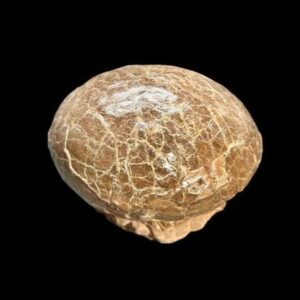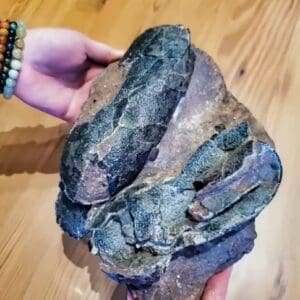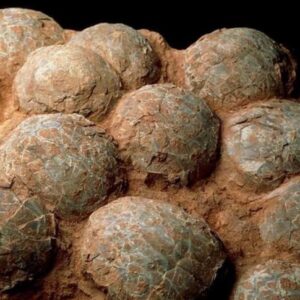Up until the 1980s, discovering fossilized dinosaur eggs and the bones of young dinos was incredibly rare. Over the last 40 years, fossilized dinosaur eggs have been found on several continents and I remember when they showed up at the Tucson Gem and Mineral show. Everyone was very skeptical of them being original because they were sourced from China. After a couple of days of professional rock hounds inspecting the specimens, visitors became really excited about the new find.
Years later, hatchlings, juveniles, and adult dinosaur fossils kept showing up at the major rock and gems shows. It also helps to have a really cool movie called Jurassic Park to stir up interest in fossils.
As far as anyone truly knows, all species of dinosaurs laid eggs, which is true for most reptiles or sauropsids. However, it’s insanely difficult to identify the species of dinosaurs responsible for laying the eggs that have been discovered. This is because only a few dino embryos have been found intact inside of the eggs. Past that, it would all be speculation.
Identifying Fossilized Eggs
To untrained eyes, a collection or nest of fossilized dinosaur eggs would look very similar to a pile of pebbles or rocks. But there are a few things we can look at to know if we indeed possess a real fossilized egg. Don’t be frustrated if you have a hard time identifying fossilized eggs because even the professionals get it wrong from time to time.
- The location where the egg was found is one of the first things to look at and ask about. If the fossil dealer doesn’t know where it came from or provides a geographic area where they’ve never been found then you might want to be cautious. Dinosaur fossils only turn up in specific rock formations in particular regions of the world.
- Actual fossil eggs typically have easily identifiable shells that are significantly different from the sediment surrounding them. The eggs usually have fine surface ornamentation or specific types of crystalline structures in their cross-sections.
- The thickness of the eggs should be uniform (roughly). They’re typically slightly curved, with their surface covered in tiny pores. If you check the shell over with a magnifying glass and can’t find pores, you’re most likely examining a rock, but if you can see pores, you’re golden (maybe).
- Fossilized eggshells are almost always heavily cracked with a noticeable shifting of the shell because they tend to be brittle. If you’re in possession of something that is incredibly egg-shaped, it’s most likely not a dino egg.
- Lick the egg! Fossilized dinosaur eggs usually stick slightly to the tongue. They should be stickier than ordinary rocks due to their porous nature.

Fossilized Eggs Value
True fossilized dinosaur eggs can range between hundreds to thousands of dollars. The value changes based on the type of originality, the location where it was found, if they’re singular or in a nest, its condition, rarity, and age.
The typical value of a standard egg is between $400.00 to $1500.00.
Let’s look into some aspects that determine a fossilized egg’s value.
Fossilized Egg’s Age: The older an egg, the greater its value.
Eggs With Intact Embryo: These are a rare find and challenging to find. While it’s rare, it’s possible. The last fossilized dinosaur egg with the embryo was found in China in 2016.
Species or Type: Similar to gems and crystals, there are several species whose fossils are valued at various prices. However, the type of dinosaur egg one has isn’t always identifiable.
A Collection: Finding a nest or collection of eggs adds a lot of value to a specimen. The more you have from one nest, the more the value increases.

Can Fossilized Dinosaur Eggs Hatch?
Nope. It would be something amazing if fossilized dinosaur eggs could be hatched. However, unfortunately, fossilized eggs do not contain a viable embryo within, so there isn’t anything to incubate and hatch. The embryo is no longer living, and therefore, no life can come from it.

Where Are Fossilized Dinosaur Eggs Found?
Wherever dinosaur fossils have been found, there’s a chance that somewhere in that vicinity might be fossilized dinosaur eggs. We can’t say how far in proximity they may or may not be, but they’re around.
Many dinosaur eggs have been discovered in sand dunes. The sandstone deposits formed in ancient dune fields of what is now northern China and Mongolia. In this situation, the presence of Oviraptors was found preserved in their life-brooding position, which suggests the eggs, nests, and even parents might have been buried rapidly in sandstorms.
Looking at the United States, a remarkable find was located in Montana. The fossils of Duckbill dinosaurs, which included nests, eggs, hatchlings, juveniles, and adults, were found all together in one mass grave.
During the 1970s, a group of teenagers found a fossilized dinosaur with the embryo intact in Selma, Alabama. A clutch of rare dinosaur eggs was found on the cliffs of Utah by a researcher from North Carolina State University.
The PBDB Navigator is an interactive map that allows us to check out the locations of every fossil found by scientists. This includes everything from early mammals to dinosaurs!
Suppose you have a suspected fossilized dinosaur egg and want to have it checked out. In that case, you can contact your local Museum of Natural Science and History. If there isn’t one near you, call any museum of science or history that’s in your state, and they can help better direct you.
- Identify Enstatite - March 12, 2024
- Identify Cerussite - March 3, 2024
- Identify Bytownite - February 18, 2024
